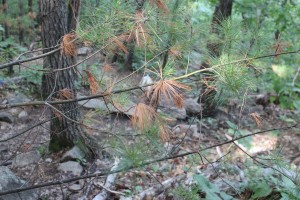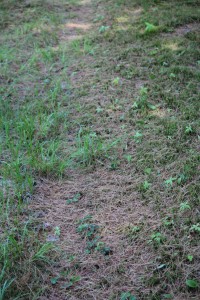White Pine Needle Cast Raises Questions in Maine
Out and About for the Sebago Lakes Region of Maine June 18-24
June 17, 2015Out and About for the Bangor Lakes Region of Maine June 25-July 1
June 24, 2015White Pine Needle Cast Raises Questions in Maine
Morning Sun on Keoka Lake, Waterford, Maine
by Leigh Macmillen Hayes
As a Maine lakefront property owner, you may be acutely aware that in recent weeks pine needles have been turning brown and shedding in significant numbers.
Driving near Keoka Lake in Waterford recently, it seemed like all of the pines were more brown than green. And the same was true as I climbed Mount Tire’m on Plummer Hill Road.
For the last eight or nine years, our highly valued Eastern White Pine trees have displayed this needle die-off in different areas of the state during June.

Though pines are evergreens, it’s important to note that their needles don’t stay on forever—usually three years of needles are present during the summer and two years during the winter, because the oldest year’s needles typically turn brown and fall off in autumn months.

But . . . the fact that they are shedding significantly in late spring/early summer makes me wonder if the trees will die.
Turns out the needle cast is caused by several fungi that attack new growth during a wet period in May. Though this spring has not been as wet as in recent years, the defoliation is a result of last year’s infestation. That’s how this works—a fungus or two or three attack when the needles emerge and conditions are right, and the following year, the needles turn yellow, then brown and finally drop.
When this first began occurring, it was believed that the trees could survive for three years. Well, we’ve passed that mark and, thankfully, most of the trees are still with us.
The damage appears to be most severe in poor growing sites with shallow soil, near lakes and ponds, in other wet areas and on dry, steep slopes. I’ve seen it on mountain trails, such as the one up Mount Tire’m and on Pleasant Mountain in Bridgton and Denmark.
Already weakened trees may not be so lucky. Just like in beech trees, where the minute beech scale insect creates an entry way for the nectria fungi to enter and infect the tree, we have to wonder if the same is happening with the white pines. Does this open the door for other diseases to inoculate the trees? It certainly must stress the trees, making them more vulnerable.
The Maine Forest Service and USDA Forest Service are monitoring the situation and working to develop better management plans. Cutting trees down and using fungicides are not recommended.
We do need to acknowledge that many pines produced a vast amount of pine cones last year, indicating that most trees remained healthy.
Since this spring has not been as wet, we have to hope that the trees will not undergo the same stress next year. But only time will tell.
To learn more about lakefront properties for sale on Keoka Lake in Waterford, Maine, click on the green box above.
To learn more about the Waterford area, check out these blog links below.
Keoka Lake in Waterford, Maine is One Family’s Retreat, Accessible to All
Summer Visitors Enjoy Historic Waterford Flat and Keoka Lake

